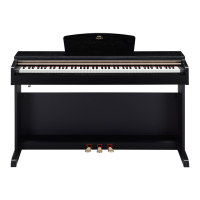16
YDP-161/141 Owner’s Manual
ENGLISH
Selecting & Playing Voices
Selecting Voices
To understand the
characteristics of various
voices, listen to demo songs
for each voice (page 13).
Selecting a voice
automatically engages the
best-suited reverb type and
depth (page 18) for that
particular voice.
Press and release the [PIANO/VOICE] button to select the Grand Piano 1 voice.
Press and release the [PIANO/VOICE] button, then press the [+ R] or [– L] button to
select a different voice.
If you wish to select a particular voice directly, press and hold down the [PIANO/VOICE]
button, then press one of the C1–A1 (YDP-161) or C1–F1 (YDP-141) keys.
Turn the [MASTER VOLUME] control to adjust the volume level while playing the keyboard.
YDP-161
YDP-141
Voice:
On this instrument, a voice
means a “tone” or “tonal
color.”
C
1D
1F
1G
1
C1 D1 E1 F1 G1 A1
The lowest key
Key Voice Name Description
C1 Grand Piano 1
Recorded samples from a full concert grand piano. Perfect for classical
compositions as well as any other style that requires acoustic piano.
C
1 Grand Piano 2 Spacious and clear piano with bright reverb. Good for popular music.
D1 E.Piano 1 An electronic piano sound created by FM synthesis. Good for popular music.
D
1 E.Piano 2
The sound of an electric piano using hammer-struck metallic “tines.” Soft tone when
played lightly, and an aggressive tone when played hard.
E1 Harpsichord 1
The definitive instrument for baroque music. Since the strings of a harpsichord are
plucked, there is no touch response.
F1 Harpsichord 2 Mixes the same voice an octave higher for a more brilliant tone.
F
1 Vibraphone The sound of a vibraphone played with relatively soft mallets.
G1 Church Organ 1
This is a typical pipe organ sound (8 feet + 4 feet + 2 feet). Good for sacred music
from the Baroque period.
G
1 Church Organ 2
This is the organ’s full coupler sound, often associated with Bach’s “Toccata and
Fugue”.
A1 Strings
Spacious and large-scale string ensemble. Try combining this voice with piano in
DUAL mode.
Key Voice Name Description
C1 Grand Piano 1
Recorded samples from a full concert grand piano. Perfect for classical
compositions as well as any other style that requires acoustic piano.
C
1 Grand Piano 2 Spacious and clear piano with bright reverb. Good for popular music.
D1 E.Piano An electronic piano sound created by FM synthesis. Good for popular music.
D
1 Harpsichord
The definitive instrument for baroque music. Since the strings of a harpsichord are
plucked, there is no touch response.
E1 Church Organ
This is a typical pipe organ sound (8 feet + 4 feet + 2 feet). Good for sacred music
from the Baroque period.
F1 Strings
Spacious and large-scale string ensemble. Try combining this voice with piano in
DUAL mode.

